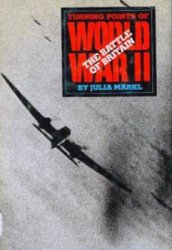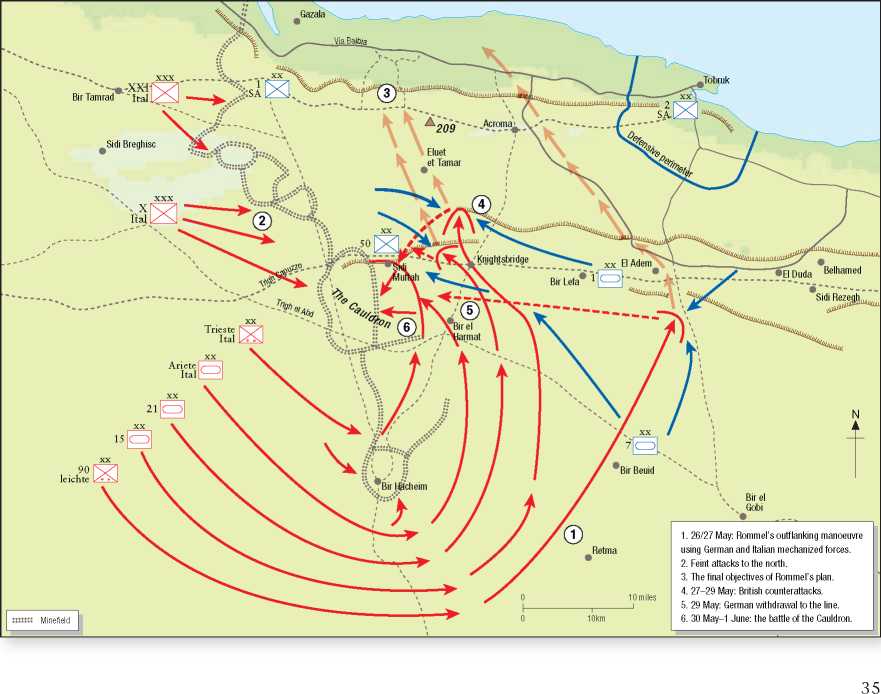
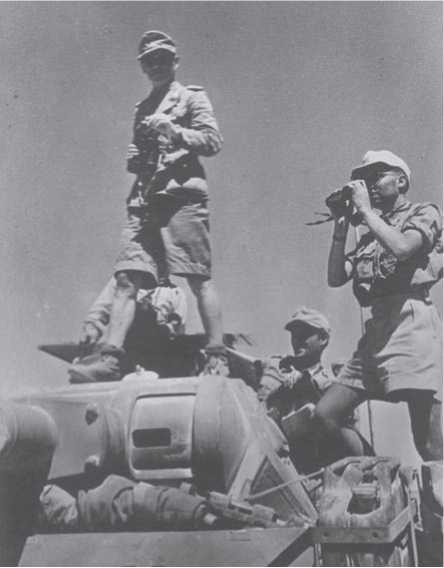
Checking the battlefield from the only feature available in the desert: a tank turret. Rommel's style of command combined with the environmental conditions took a heavy toll on the men of the Afrikakorps. Casualties were high, particularly amongst officers, as were sickness rates. By the summer of 1942 Rommel reckoned he still had with him only half of those who arrived in 1941. (Carlo Pecchi)
Open, which is where Rommel wanted them to be. In an opposite scenario to that taking place on European battlefields, Rommel believed that encirclement could only lead to the destruction of the enemy forces when their lack of supplies had made them immobile or because of inadequate command or heavy losses. Since sealed pockets were hard to achieve in the desert, the first was an unlikely occurrence, 'The encirclement of the enemy and its subsequent destruction in the pocket can seldom be the direct aim of an operation; more often it is only indirect, for any fully motorized force whose organisational structure remains intact will normally and in suitable country be able to break out at will through an improvised defensive ring' (The Rommel Papers, p. 199).
Annihilation was to be achieved rather by 'battles of attrition, battles in the open aimed at destroying the fighting power of the enemy by wearing down their materiel and breaking their cohesion'. These battles, fought 'with the highest possible degree of mobility' (The Rommel Papers, p. 199), required concentration of forces in order to isolate portions of the enemy's force and defeat them in detail. Essential requirements included the preservation of one's own supply lines, the use of armour as main spearhead, effective field reconnaissance, concealment of one's own intentions and 'Speed of movement and the organisational cohesion of one's own forces' (The Rommel Papers, p. 200).
Rommel would call his plan Operation Theseus, and he launched it on the night of 26 May against the Gazala Line. This was a bold decision and possibly the closest thing to a gamble he ever tried. to their training the German divisions marched at night to the south of the line, outflanked it and the morning after appeared between El Adem and Acroma. For a while it looked like German forces had marched into a trap and at this point Rommel took over, and the German method of command proved its superiority over the British one. Having appreciated the situation at first hand, Rommel decided to alter his plan completely and try another
Approach. After three days of battle he ordered mobile forces to withdraw westwards to secure his supply routes and establish a defensive line against British mobile forces. The 'battle of the cauldron' saw Rommel opening a supply route to the west and repulsing British counteroffensives, each committed piecemeal and ending with severe losses. By 11 June the second major stronghold on the line, Bir Hacheim, was in Axis hands and finally, on 12-13 June, Rommel fought the decisive battle in the open that opened the way to Tobruk. Between 17 and 19 June Tobruk was encircled again, this time
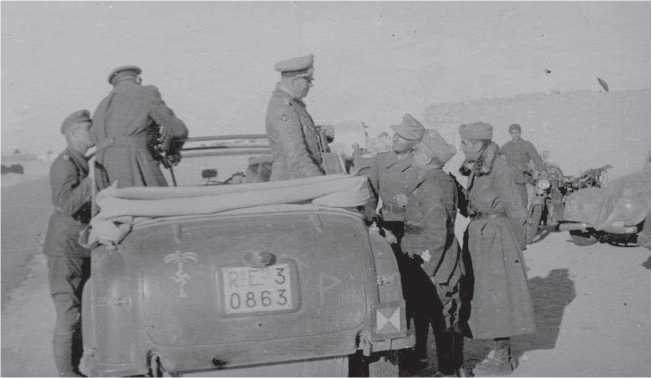
With no chance of holding out, and stormed on the 20th with the garrison surrendering the following day, a huge source of booty for the Axis forces and Rommel's greatest victory. With the enemy forces apparently annihilated and their remnants withdrawing eastwards, Rommel saw again the same opportunity that flashed through his mind while advancing into Cyrenaica during the previous spring: the Suez Canal and a decisive victory in North Africa. The day before his promotion to Generalfeldmarschall, and even before Hitler gave him a green light on the 24th Rommel set the Afrikakorps en route to the Egyptian border, while at the same time abandoning the planned assault on Malta. By 26 June the Axis forces were at Mersa Matruh, where Rommel won another victory and resumed his advance to the canal on the 28th. Two days later the British forces withdrew to the El Alamein Line, which was attacked on 1 July following the same pattern as the attack at Gazala: a breakthrough of the enemy defence line with the aim of bringing its forces to battle in the open where they would be destroyed piecemeal.
The first attempt to break through the Alamein Line failed, and the Australian counterattack on 10-11 July brought the first serious setback of the campaign, with the Italians collapsing in the north. From this point onwards Rommel was to face failure.
The battle of Alam Halfa (for the Germans Second Alamein) of 30 August-6 September 1942 was a pale attempt at executing another breakthrough battle in the manner of Gazala.
With the Panzerarmee now exhausted and lacking supplies, Rommel had no chance of winning. Once more his 'tremendous' (as he
Rommel's car, an Italian Alfa Romeo 2500 coloniale, is a clear example of recycling: first in use with the Italian army, as denoted by the license plate reading Regio Esercito, it entered Afrikakorps service, was given the typical palm and swastika symbol and, as denoted by the tactical insignia on the right mudguard, was used by the staff of Panzergruppe Afrika. (HITM)
Rommel with Generalmajor Bernhard Hermann Ramcke, commander of the Luftwaffe's Ramcke Brigade, intended for use on Malta and then deployed at El Alamein. (HITM)
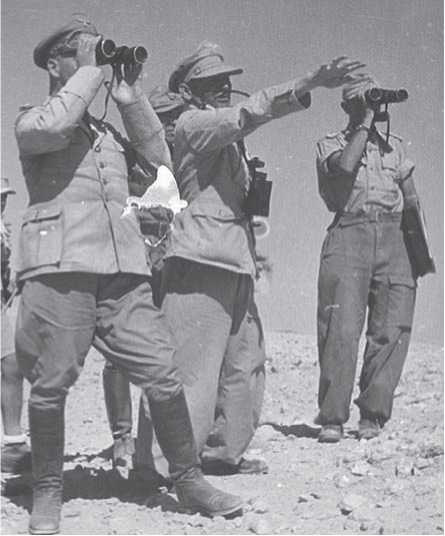
Called them) demands had been well beyond the capabilities and the conditions of his own troops, he had also underestimated the capabilities of the enemy forces, the harshness of the terrain and climate in the Egyptian desert and his overstretched supply lines, which added further strain to an already troublesome logistical situation. Reading Rommel's own account, the problems of inadequate supplies and of the physical endurance of his men are clearly evident, as are the reasons behind the failure at Alam Halfa: lack of supplies and enemy air superiority. In September 1942 Rommel, according to his papers, realized the campaign could not be won at
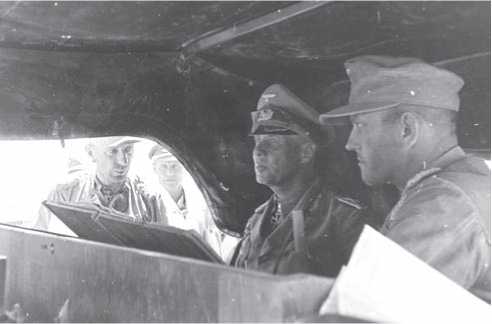
The Generalfeldmarschall inside a staff car, talking with his commanders. Rommel's face clearly shows signs of strain and physical exhaustion. (HITM)
El Alamein unless adequate supplies and reinforcements were provided; they were not. The overly optimistic mood he displayed while in Germany, where he went on 23 September to recover from illness caused by his prolonged stay in Africa, was just circumstance and an attempt to 'bring some postponement to the British offensive' (The Rommel Papers, p. 295).
Fatal hours: meeting in the desert
Rommel, wearing a leather overcoat with a civilian scarf given to him by his sister, meets his commanders in the field just before the decisive armour battle of 12-13 June 1942 at the Knightsbridge defensive box. The group in the foreground includes
Generals Walther Nehring (1) and Georg von Bismarck (2); Oberst Fritz Bayerlein is attending (3). Nehring, seen wearing the tropical version of a motorcyclist's overcoat, was commander-in-chief of the Afrikakorps between 9 March and 31 August 1942, when he was badly wounded during an air attack and sent back to Germany. Bismarck was killed in the same ill-fated attack against the Alam Halfa ridge when his command tank exploded. Bismarck, an outstanding tactical leader and probably the best divisional commander in North Africa at the time, had been a motorized infantry regiment commander with Rommel's 7. Panzer-Division in France in 1940 and, after having served on the Eastern Front in 1941, was sent to North Africa at Rommel's request and took over command of the 21. Panzer-Division on 11 February 1942. Nehring was chief of staff of Guderian's corps in 1939-40 until he became commander of the 18. Panzer-Division and fought on the Eastern Front in 1941, before being transferred to North Africa. Between November and December 1942 he took command of the Tunisian bridgehead, being sent back to the Eastern Front in February 1943. There he eventually became commander-in-chief of 1. Panzerarmee on 19 March 1945, before being placed in the reserve on 3 April. Bayerlein, who like Bismarck is wearing the tropical uniform of the Afrikakorps, was chief of operations in Guderian's corps (later Panzergruppe) until late 1941 when he was sent to North Africa where he served mainly as chief of staff of the Afrikakorps. In January 1944 he was given command of the Panzer Lehr Division, a task that overwhelmed him. Behind the group stand Rommel's SdKfz 250/3 (4) and Bismarck's SdKfz 251/3 (5) command vehicles.
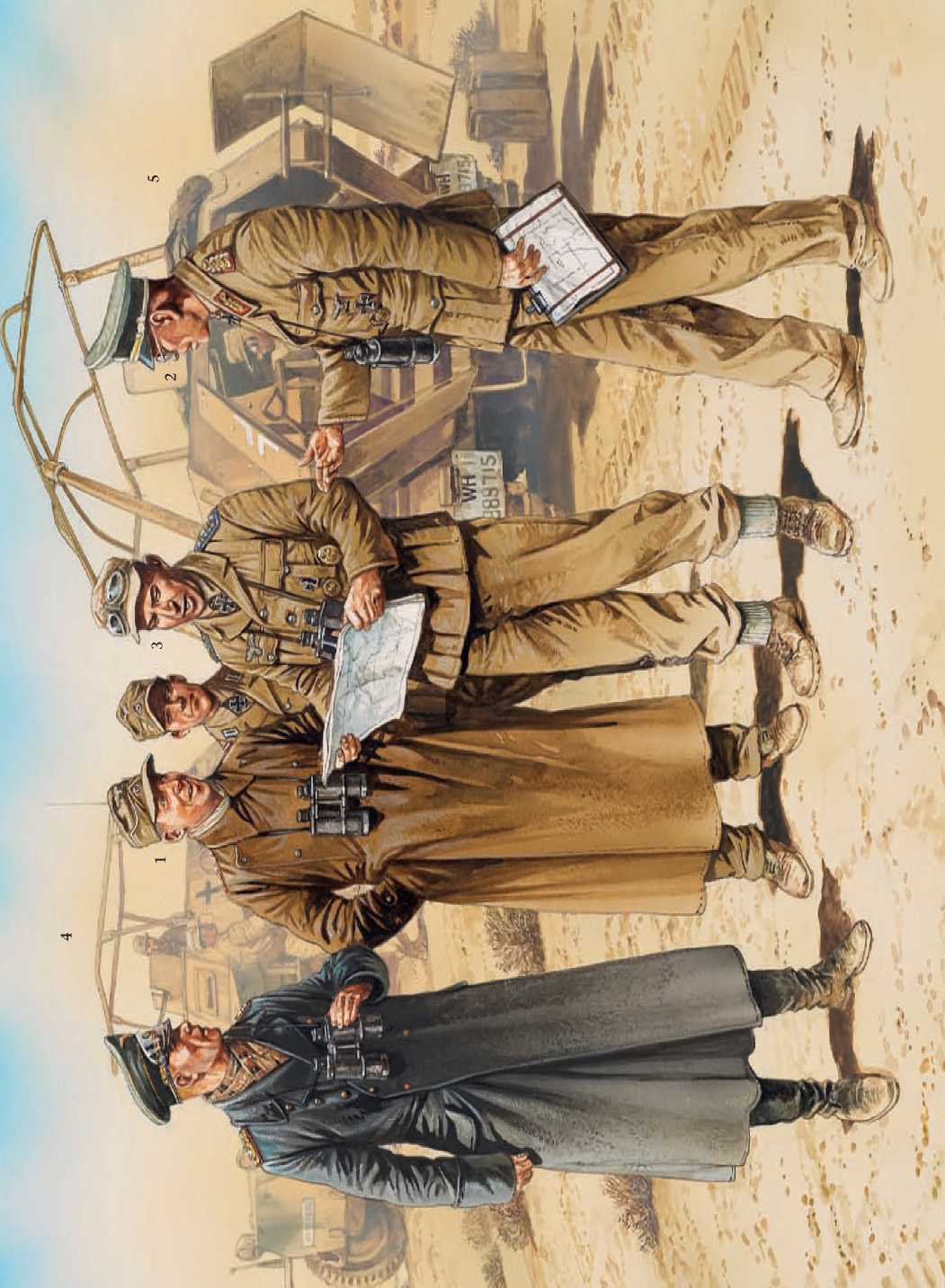
A Panzer column in Tunisia, early 1943, with a heavy Tiger I tank followed by a PzKpfw III. Rommel would spend only one month in this new theatre, leading the unsuccessful attack at the Kasserine Pass. (Carlo Pecchi)
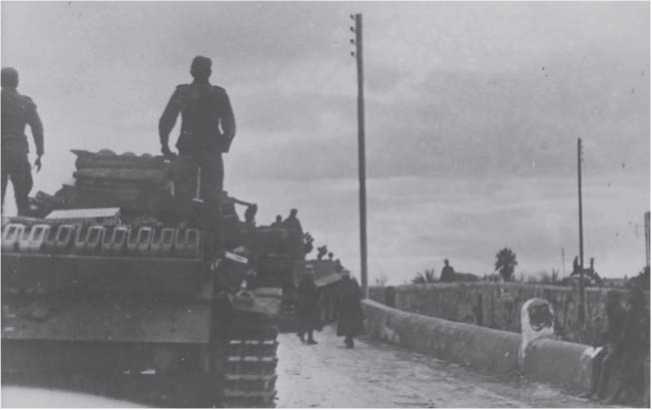
However, Rommel also considered that he might inflict a serious enough defeat on the forthcoming British assault that the whole balance would be shifted. The defences at El Alamein were structured according to the typical German tactical doctrine, a pattern Rommel would also implement some time later in Normandy. It consisted of a rigid defence based on a static line, heavily fortified and mined, manned by the infantry who had the task of standing fast and repulsing the enemy attacks. Whenever a breakthrough occurred, mobile armoured forces would intervene to counterattack and re-establish the situation on the defence line. This was a solid strategy suited to the terrain and, as Rommel pointed out, imposed by the lack of supplies and of mobility of the Axis forces. The decisive attack at Alamein started on 23 October and, on Hitler's order, on the evening of the 24th Rommel returned to the Panzerarmee. The first phase of the British offensive seemed to play into the hands of the Axis forces, but when the second phase was unleashed on 27 October it soon became clear that the enemy superiority in numbers and firepower was going to overwhelm the Axis position.
On the evening of 2 November Rommel realized how desperate the situation was and ordered a staged withdrawal to the Fuka Line, but the following day got a message from Hitler ordering him to stand fast at Alamein, giving no alternative between victory or death. Rommel was deeply shocked by this order and struggled with it for more than a day until, early in the afternoon of 4 November, he ordered the Panzerarmee to withdraw no matter what. That marked the beginning of a retreat, skilfully managed by Rommel, which ended on mid-February 1943 when the Panzerarmee Afrika settled into the defensive positions of the Mareth Line in Tunisia, where the Axis forces established a bridgehead in November following the Allied invasion of the French north-west African colonies on 8 November 1942. It was soon clear that the Axis presence in North Africa was coming to an end, as demonstrated by the short-lived attack at Kasserine Pass on 19-22 February 1943. The following day Rommel was
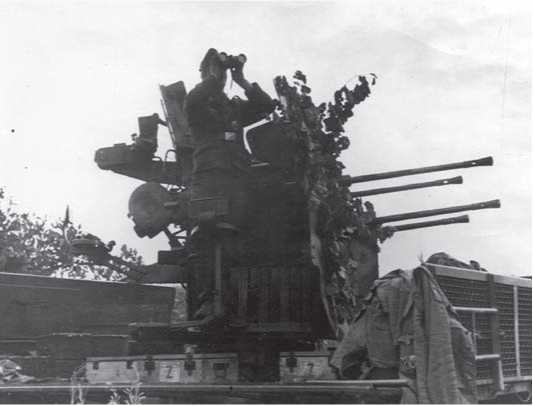
Given command of the newly formed Heeresgruppe Afrika, which he held for a fortnight. On 9 March he was back to Germany on account of his health, leaving Africa for ever.
His Afrikakorps survived only two more months.
The image of Rommel after the end of the North African campaign is that of a broken man. The capitulation of Axis forces in Tunisia on 13 May sent him spiralling into a state of depression, and only on 23 July was he given command of a Heeresgruppe intended to defend Greece from Allied invasion. Mussolini's downfall
Two days later brought a change of destination, and by the end of July he was in northern Italy in charge of Heeresgruppe B. Following the Italian surrender on 8 September 1943 his forces seized the whole area, disarming hundreds of thousands of Italians, in about a week. Rommel hoped to have command of the whole of Italy, but his plan of defence disappointed Hitler. Because of the exposed flanks of the Italian Peninsula, Rommel wanted to withdraw to northern Italy where an elastic defence could be conducted. On 19 October Hitler was about to appoint him but changed his mind, and command in Italy went to Generalfeldmarschall Albert Kesselring, whose delaying defence was exactly what Hitler had in mind. Rommel and part of his staff were sent to northern France on 5 November 1943, at first with the task of supervising the construction of fortifications on the Atlantic Wall, then as commander of Heeresgruppe B in north-west France.
A Luftwaffe 20mm RakvierLIng 38 on a self-propelled mount in Normandy, 1944.
By this stage anti-aircraft artillery was the main tool available to the Germans to counter the ever -increasing threat posed by Allied air superiority. (HITM)
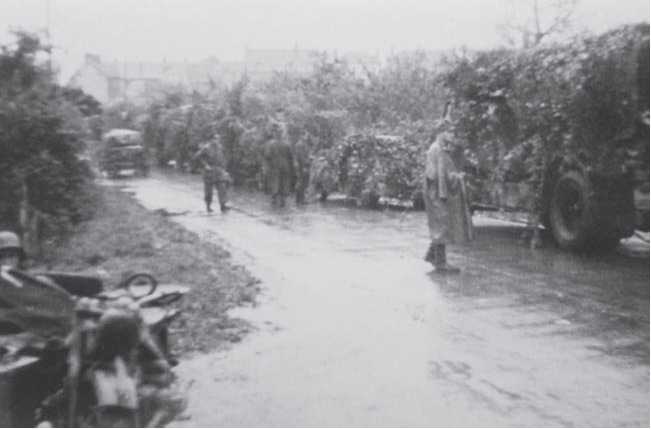
A German armoured column on the move in Normandy, June 1944. Heavy use of foliage to protect against the Allied air attacks was of little use during the day, and often units had to move using the cover of darkness thus delaying their arrival at the front. (HITM)




 World History
World History


